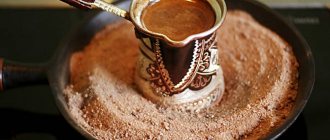History of appearance
A coffee drink made from barley spread to Italy in the mid-30s of the 20th century. Italian troops invaded Ethiopia in 1935, and the League of Nations imposed trade sanctions on the country. Food imports were strictly limited, coffee supplies were running low, and espresso lovers were forced to look for substitutes.
To make the drink more natural, more ground barley was added than usual, and the malt flavor was muffled with milk. The Italians called the new product Caffè d'orzo, which translated means “barley coffee.” The popularization of the substitute was facilitated by the propaganda of that time, calling on the population to abandon imported goods and luxury goods.
During World War II and the difficult post-war times, Caffè d'orzo was sold throughout Europe. Barley coffee was drunk for the longest time in Spain - even in the 50s, there were about two dozen producers of the substitute in the country.
The drink experienced a rebirth due to the mass passion for a healthy lifestyle. In Italy, a coffee drink made from barley can be tasted in vending machines and even in bars and restaurants - baristas brew it in a regular espresso machine.
When properly roasted, barley coffee cannot be distinguished from regular coffee in appearance.
Barley coffee production technology
To produce a coffee substitute, organic barley is used, grown without chemical fertilizers and pesticides. The collected grains are cleaned of foreign impurities. Then the hard shell is removed, since the husk can ruin the appearance of the drink. In Italy, special varieties of hulless barley are cultivated that require minimal processing.
The prepared raw materials are fried in cylindrical drums at a temperature not exceeding 200 °C. Then the grains are cooled using special devices and packaged in sealed bags. Companies produce different types of barley coffee: grain, ground and in capsules. Instant varieties are produced using a technology similar to the production of regular coffee.
Storing barley. Physiological, biochemical and physicochemical processes
Unsettled, freshly harvested barley does not germinate well. Therefore, to achieve physiological maturity, it must be given time to ripen under certain conditions. Post-harvest ripening takes place from 4 to 8 weeks.
The reason for poor germination is the lack of air flow to the embryo, because The structure of barley shells after harvesting is impermeable to oxygen; it is impregnated with substances such as fat, wax, etc. To speed up ripening, the grain is blown with hot air t=80 0C for 4 minutes or warm air t=40-50 0C for about 2-4 hours to a humidity of 12%. Low heating temperature increases enzymatic activity. During post-harvest ripening and heat treatment, inhibitors are destroyed and the grain becomes physiologically ready for germination.
During storage, processes such as respiration and self-heating of grain .
During storage, the grain is in a dormant state.
Humidity of 14-15% is called critical humidity. The moisture in the grain, as you might guess, is represented by water.
It is in 2 states:
- free
- related
Substances found in grains are capable of binding large amounts of water. The process of moisture absorption occurs until the grain moisture reaches equilibrium with the ambient humidity (equilibrium moisture).
The fastest absorption of water occurs in the embryo, then in the grain shells, then in the endosperm. Do not forget that grain has the ability to absorb moisture from various impurities, so the grain is cleaned before storage.
Structure and taste of barley drink
The color and consistency of barley coffee is very similar in appearance to the natural product. The size of the crema will depend on the method of preparation - an espresso machine produces a denser and fluffier crema than when brewing in a Turk.
Barley does not contain as many essential oils as coffee beans, so it does not leave traces or odors on the dishes. The taste is soft, with notes of fried bread; when chicory is present, the coffee tones become more pronounced. Adding milk makes the drink similar to cappuccino.
Chemical composition of barley
The average moisture content of barley grain is 13-15%, but depending on the climatic conditions of the harvest it can vary from 8% to 20%. For best storage, grain should have a moisture content of 15%. Humidity below 10% leads to an irreversible deterioration in grain germination. The rest of the grain is called dry matter (DM), it includes:
- Total carbohydrates 70.0 - 85.0%
- Protein 8.0 – 16.0%
- Minerals 2.0—3.0%
- Fats 2.0—5.0%
- Other substances 1.0—2.0%
General carbohydrates are represented by starch (50-63%), simple sugars and cellulose. Most of the carbohydrates in grains are stored in a state inaccessible to yeast. A small amount of sugars is mainly represented by sucrose, which is formed during the partial destruction of starch during storage and harvesting.
We should not forget about cellulose - a structural component of grain shells. Enzymes formed during grain germination are not able to destroy it. However, in brewing it is not necessary to additionally introduce microbiological enzymes to destroy it and obtain a higher yield of alcohol. When preparing beer, it is worth preserving the cellulose grain shells, because... they act as a filter material.
Proteins include high molecular weight proteins (proteins) and their breakdown products.
Proteins are high molecular weight proteins consisting of a large number of different amino acids that are insoluble in water. When boiling, most of the proteins coagulate and precipitate.
Decomposition products make up a smaller part of the total amount of protein and are divided into 2 subgroups:
- High molecular weight breakdown products
- Low molecular weight breakdown products
High molecular weight breakdown products and proteins are not digested by yeast. High molecular weight breakdown products are responsible for foaming, and proteins can be broken down into high and low molecular weight breakdown products during malting, mashing and fermentation. Also, during the malting process, some proteins are converted into the very enzymes we need.
For yeast, low molecular weight breakdown products are of particular value. They are also called amino acids. Amino acids are actively used by yeast as building materials and also play an important role in the formation of aroma. During the malting process, enzymes also accumulate in the grain, which break down proteins into high and low molecular weight products.
The protein norm in barley is 10.5-11% . A decrease in this value leads to a decrease in the enzymatic activity of the grain, which in turn affects the malting processes and leads to a lack of foaming in the drink. An increase in protein leads to poor filtration and poor colloidal stability (the appearance of cloudiness).
Minerals are necessary for the active development of the yeast cell.
Fats are mainly contained in the germ (10-40% of dry matter) and the aleurone layer (6-12%), in the endosperm 2%.
About 1.7% of barley dry matter is fatty acids, most of them unsaturated. The fatty acid composition is important in terms of its influence on foaming. High molecular weight unsaturated fatty acids, such as linoleic, palmitic, oleic, linolenic, have a negative effect. They cause “beer aging”—they lead to changes in the chemical composition during storage. However, these acids are used by yeast to build cell membranes (during growth and reproduction), necessary when there is a lack of oxygen at the beginning of beer fermentation.
Fats are a high-energy reserve substance that is used during grain germination.
During germination, grain loses about 30% of lipids as a result of hydrolysis (the breakdown of complex substances into simple ones) into glycerol and fatty acids. Some fatty acids are involved in metabolism, namely in the synthesis of root and sprout. The other part is further cleaved by the enzyme lipoxygenase, which is activated in the embryo during germination. Hydrolysis products are responsible for the appearance of a cucumber odor during malt germination.
Other substances include tannins, polyphenols and vitamins.
Tannins and polyphenols are contained in the grain shells. By their nature, these components have high aromatic properties and carry an unpleasant bitter taste. They are inhibitors of grain germination; in beer they negatively affect the taste, color and colloidal stability of beer.
Vitamins in grains are mainly represented by the water-soluble group. They actively participate in metabolic processes occurring in the yeast cell. A lack of vitamins negatively affects the speed of fermentation and the quality of the process, as well as the general condition of the yeast cell.
Benefits and possible harms of barley coffee
The main advantage of the product is the complete absence of caffeine, so the substitute can be drunk by people for whom regular coffee is contraindicated.
Beneficial features:
- Helps lower blood sugar, which is useful for diabetics;
- does not contain cholesterol, is safe for metabolic disorders and excess weight;
- acts as an antioxidant and strengthens the immune system;
- relieves intestinal problems;
- treats inflammation of the respiratory tract and nasopharynx;
- increases hemoglobin due to high iron content.
Barley drink is recommended for young children due to its high content of vitamins and microelements. For women during pregnancy, the substitute will serve as an alternative to regular coffee.
Barley drink can be brewed in an espresso coffee maker
Despite many beneficial qualities, excessive consumption of the drink can also be harmful. Roasted beans contain acrylamide, a toxic compound that is formed during cooking. The percentage of harmful substances in soluble varieties is especially high.
Caffè d'orzo is contraindicated for people prone to allergic reactions to grains, and is also dangerous for those with celiac disease - gluten intolerance.
Grain structure
Barley grain is a grain consisting of the main parts:
- Germinal part
- Mealy body
- Shells
The embryonic part consists of the embryos of the stem, root and leaf.
The embryo is separated from the mealy body (endosperm) by a shield and a layer of epithelium - vertically shaped cells with very thin walls.
The endosperm (mealy body) consists of cells with large and small starch grains. The cell walls are mainly composed of polysaccharides b-glucans 70%. The remaining 30% consists of: pentosans, protein, mannan, cellulose, phenolic and uronic acids.
The mealy body is surrounded by an aleurone layer , consisting of numerous cells rich in proteins. During malting, it is the aleurone layer that serves as the site of enzyme formation.
The cells of the aleurone layer include aleurone grains with surrounding cell walls. Aleurone grains consist of protein and do not contain starch; the cell walls include structural carbohydrates: pentosans (70%) and b-glucans (30%).
Following the aleurone layer are the membranes . They consist of cell layers united by 3 main membranes:
- Chaff or flower
- Fruit or pericarp
- Seed or dough
Of the grains used in brewing, only barley has a chaff shell. It remains virtually unchanged during malting. It consists mainly of cellulose and small amounts of lipids (fats), silicic acid and polyphenols, which are important in mash filtration and grain germination, while at the same time negatively affecting the colloidal stability of beer.
The structure of the fruit shell is very thin and does not have any special effect on the quality of beer. Often the fruit shell fuses with the seed coat.
The seed coat contains a large amount of phenolic compounds that reduce the colloidal stability of beer.
Methods for making barley coffee
You can roast barley for coffee yourself; to do this, the grains are first washed and dried.
There are two cooking methods:
- in the oven at a temperature of 170-180 °C;
- in a frying pan over low heat.
To ensure even frying, shake the pan periodically, trying to avoid burning. The finished product is characterized by an amber color and the smell of fresh baked goods. The barley is then ground in a coffee grinder. The powder does not tolerate high humidity, so it is recommended to use it immediately and not make reserves for future use.
Brewing recipes
- Pour 3 teaspoons of powder into a glass of water, bring to a boil in a pot, add sugar.
- Dilute 150 ml of whole milk with half and half water, put on fire, bring to a boil, add 5 teaspoons of ground barley, cook for 2-3 minutes.
- Heat a ceramic cup, add 3 teaspoons of barley powder and sugar to taste. Pour in a small amount of hot water, stir, top up, close with a lid and let stand for 4-5 minutes.
You can safely experiment with the drink - add honey, syrup, lemon or ice cream. To give coffee a rich color and aroma, barley is mixed with chicory.
How instant coffee is made
Any instant coffee goes through 3 main stages of production: preparation, extraction and conversion of the extract into a dry product.
It all starts the same.
- In the first step, the raw coffee beans are inspected, roasted, and crushed into large pieces (much larger than any home or restaurant grinder).
- At the second stage, the grains are placed in special tanks, where they are boiled until a concentrate as thick as oil is obtained. Drinking such liquid is dangerous to health - even the strongest heart may not be able to withstand the volume of caffeine contained in it.
- At the third stage, the most interesting part begins: the future instant coffee is transferred from a liquid state to a dry state. This is where the key differences between powdered coffee, granulated and freeze-dried appear.
Powdered coffee (spray dried)
To obtain powdered coffee, concentrated coffee liquid is fed from above through a spray into a narrow, long pipe. There, microscopic droplets dry instantly under the influence of high temperature. The powder, ready for packaging, falls to the bottom of the pipe. What is special about this technology? The fact is that coffee goes through strong heat treatment twice - first it is brewed, then it is dried. At the same time, little remains of the original flavor and aroma.
That is why today this method of producing instant coffee is considered outdated and less successful. Most well-known manufacturers have switched to freeze dried technology (more on this below) and the creation of freeze-dried coffee.
Granulated coffee
Granulated coffee (also known as agglomerated coffee) is produced using the same technology as powdered coffee, but with an additional step in the form of wetting the powder and creating granules from it. This does not affect the taste of the finished drink, but it is more convenient to brew such coffee - it does not stick to the dishes like powdered coffee.
Freeze-dried coffee
Freeze-dried coffee is made by freezing and evaporating. The concentrate is first converted into small ice crystals, and then moisture is removed from these crystals, bypassing the liquid phase and without subjecting the product to additional heating.
This allows you to get a more “natural” instant coffee that retains more taste and aromatic qualities.
Ground in instant
Relatively recently, a new method has emerged that makes instant coffee even closer to the “original” taste: finely ground grains are added to the freeze-dried product. This combination allows, on the one hand, to still quickly prepare the drink by brewing with hot water, and on the other hand, to add taste and aroma to it.











